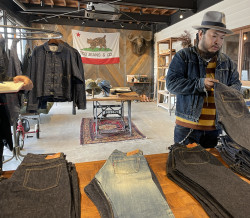
Originally published on metropolis.co.jp on May 2011

Phil Couzens
On the afternoon of March 11, seventeen-year-old Kazusa Ishii missed his English lesson. I was worriedly waiting for him in the Yokohama classroom, aftershocks rattling my whiteboard.
When I next saw Kazusa, I asked what had happened to him that terrible day. He shrugged and said he’d ended up sleeping on the concrete floor of the Pacifico Center in Minato Mirai. “It wasn’t very comfortable,” he added as an afterthought.
It wasn’t until a week later that I got the full story. First from an Asahi newspaper column written the day after the earthquake. And then, in more detail—and with some reluctance—from Kazusa himself. As you read his account, please bear in mind that this hip and fashionable high-school boy, when first asked what he’d done the day of the Tohoku earthquake, didn’t think any of the following worth mentioning.
It all started in Marui department store. Kazusa and his friends, Sayaka, Keitaro, Megumi and Muneyuki, were on the basement floor when the first earthquake struck. With the lights overhead swinging and crashing into each other, panicked adults started bolting for the stairs. Rather than join the mass exodus, however, Kazusa and his friends formed a chain and helped struggling mothers lift their baby-buggies up the steps and out of the basement.
The heroic high-schoolers were in the Cial department store when the second quake hit. Quickly making a circle, they dropped to the ground with their arms around each other. But then, noticing an elderly woman had fallen near them, they scooted over and re-worked their protective knot around her instead.
As soon as the tremors stopped, they helped the shaken septuagenarian up and walked her to Yokohama station. They sat on the floor with her, and shared food bought from a nearby kiosk. They used their mobile phones to contact her husband in Kawasaki, and let him know she was all right.
All this time, Kazusa was becoming increasingly worried about his dogs, so he and Sayaka sprinted the thirty minutes to his house to check on the animals. After stopping to feed the excited but unharmed miniature Dachshunds, the duo headed straight back to the station, their friends and the old lady.
When a policeman announced that the Pacifico Center was opening up to house people who couldn’t get home, the concerned teens decided to take the old woman there. Walking at a snail’s pace for forty minutes in the biting cold, they held the Kawasaki lady’s hands until they reached the enormous concrete structure. Inside, the staff gave them futons, and finally, the old woman could lie down and recuperate.
Kazusa and Sayaka, however, didn’t rest. Instead, they trekked all around Minato Mirai looking for still-open restaurants or convenience stores to buy food and drink. And upon returning to the conference-turned-refugee center, they shared what they’d found with everyone they could. It was then they briefly met the Asahi reporter whose conversation with Megumi made it into next morning’s paper.
Finally, at 4am, the old lady was able to go back to Yokohama station and get a train home. Kazusa and his friends were there until morning, though they hardly slept at all, having given their futons to old folks who needed them more.
So there you have it. While this thirty-five-year-old Irishman was sitting in his school feeling sorry for himself, his seventeen-year-old student was mere blocks away rescuing babies and silver-haired old ladies. And while I bedded down on sponge alphabet mats in the corner of the classroom that night, this kid could have gone home, grabbed food from his fridge and fallen into his own comfortable bed. Instead he chose to sleep on a concrete floor, so he could take care of strangers.
To make matters worse, after pulling off all this heroic Good Samaritan stuff, he won’t even boast about it? Won’t even mention it? In the end I was forced to confront him.
“What the hell are you Kazusa? Some kind of samurai?” I asked. “No one’s like this in real-life.”
“No,” he laughed. “I’m not a bushi.”
The next time I hear some grumpy baby-boomer salaryman, Tokyo Governor, or Nihonophile expat grouse that teenagers in Japan are a bunch of self-centered fashion-wimps lacking in the chivalric ninkyo spirit of their ancestors, I will remember Kazusa and his friends and think, “You have absolutely no idea what you’re talking about.”







